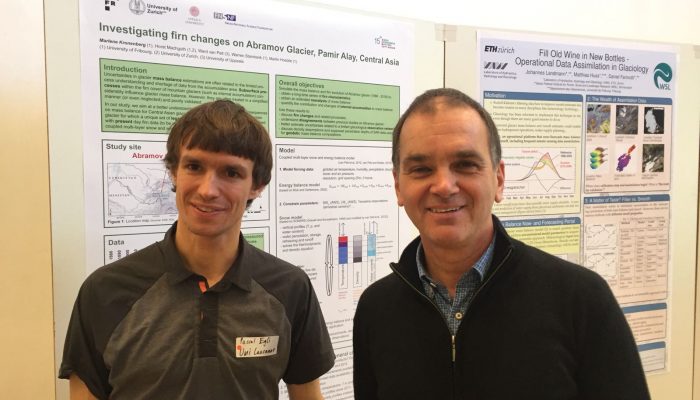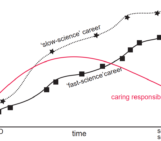
Annegret Larsen had the fantastic idea to encourage her colleague Pascal Egli, both from the University of Lausanne, to explore the nature of a shared professorship. Pascal took the chance and interviewed Professor Martin Hoelzle at the Swiss Geoscience meeting in November 2017. Professor Martin Hoelzle is a Geomorphologist/Glaciologist at University of Fribourg (Switzerland). He is also one of very few Professors that share a job, over both of which he speaks in the following interview.
- – edited by Annegret Larsen, interviewed and written by Pascal Egli, UNIL –
At the Swiss Geoscience Meeting, 18.11.2017, 12:28
Could you tell me what you are most interested in?
I am interested in the physical processes between the atmosphere and the alpine environment. My specialization is the alpine cryosphere, including both glaciers and permafrost.
I have been working in this area more than 25 years. I am mostly interested in the effects of the processes connecting the atmosphere and the cryosphere. This is especially interesting in the context of climate change, where we currently can observe very fast changes in the cryosphere, mainly induced by the atmospheric warming. The effects of this atmospheric warming, which is in high mountain and polar areas already much stronger than elsewhere, influences the high alpine environment with its very sensitive reacting cryospheric variables like snow, glaciers and permafrost strongly. The caused changes within the alpin cryospheric environment are then often are related to mass movements, thus also natural hazards. However, I would not consider myself a natural hazards specialist. I am mostly interested in the processes leading to these mass movements.
– so, for example also ‘rapid glacier retreat’ ?
Exactly, that’s why one of my core competences are long-term observations. Be it in the domain of permafrost or glaciers. Because I think that long-term observations help us also to understand better the physical relationships between the atmosphere and the cryospheric variables. Sometimes, we understand that there are new feedbacks and faster processes that we could not recognize or understand before. That’s why I think that the long-term measurements, especially in situ measurements, are still very important. With the help of these measurements, we are able to make better model based simulations for the future. A smart combination of in situ measurements with remote sensing and numerical models is the best way to reduce uncertainties. In general, I am therefore one of the clear defenders of in situ measurements within long-term monitoring strategies.
Now let us leave the science aside for a moment and talk about how you organize your work life. So you do job sharing ?
Yes, I am sharing my position with Christian Hauck since 2008. We applied for this position together. This was not very easy in the beginning because it was not even clear for the university if this type of candidacy was legal. Therefore, they first had to clarify with the Canton if such a job sharing on professor level was acceptable by law. The case was treated by the state council, who approved the request. Then, they invited us for an interview and we were lucky that they engaged us. Since then, we are working together like that – since 10 years. I am very happy with this, and Christian as well. We are still convinced that it is a good model. We would not say that it is the best model or that everyone should work like this. But we like it.
So, how do you share the work ?
From a scientific point of view we are specialized in different areas ; Christian does mainly geophysics and also soil properties in permafrost areas. And I am more specialized in surface processes on glaciers and permafrost.
Are there any negative sides of this model ?
You need a good communication. We need to get along very well from a personal point of view. And we are both very convinced by the model. There are many advantages with this model: Together, we cover a larger field of science. And if it comes to decision-making, we always have a partner at the same level to discuss the issue with. This gives you a certain safety and a different point of view. It is very positive.
What do you do besides the job ?
I have realized for myself that I need a very good work-life balance. Maybe I am a bit less stress resistant than other people. That means that I need a counter-balance to work. I practise a lot of sports and I invest time in my family. Now, my children are grown-up. But Christian’s kids are still younger, so it is very useful for him to handle it like this. That means that he also does a ‘job-sharing’ with his partner, like me, too. Both partners also work part-time. So it’s like a double job-sharing. The work-life balance is very good, and it is very satisfying.
– edited by Annegret Larsen, interviewed and written by Pascal Egli, UNIL –
If you are interested in more information on the topic have a look at these articles French and German articles that were published about the shared professorship in Fribourg.
Science et temps partiel? (French)
Conjuguer famille et travail au masculin (French)
Zwei halbe Professoren ist mehr als ein ganzer (German)
Teilzeit und Wissenschaft? (German)


